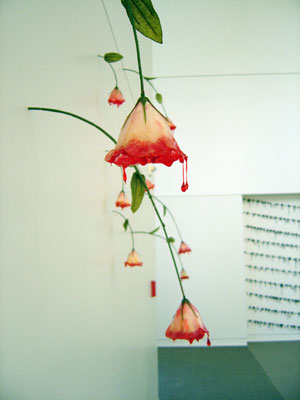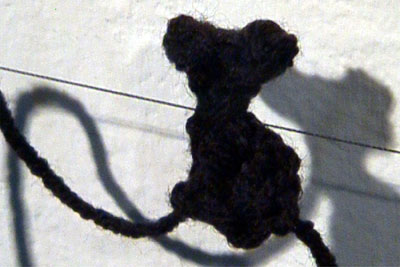|
UNR BFA Awards Exhibition
Jeanne Jo and Diana Snyder
Carson City Courthouse Gallery
August 26– November 25, 2004
. . .
CCAI UNR BFA Awards Exhibition
Essay
by Ray Hardin
Exhibition Corodinator's note: Our thanks go to
Ray Hardin, a University of Nevada Reno graduate student, for contibuting
this essay to the Awards Exhibition project.
The Capital City Arts Initiative's UNR BFA Awards Exhibition displays
the work of Jeanne Jo and Diana Snyder, two young artists just beginning
to tap the exciting potential within the many layers of their artistic
identities. This exhibit at the Carson City Courthouse
shows that both Snyder and Jo continue to
evolve new strategies-through media and methods as diverse as crochet
and candy coated silk flowers-to explore the many possibilities present
in their individual artistic visions.
Jeanne Jo's work engages, at every turn, both the limitations of artistic
media and the cultural buttresses that act as barriers to freer forms
of artistic expression.
Jo devotes herself, as she puts it, to "addressing issues of beauty, pain, and
obsession as they relate to my personal identity." Her background plays into
her cultural and artistic explorations. As the child of a Korean immigrant and
an American, Jo "grew up the child of two cultures." This has given her "a valuable
view on identity," she explains. "My work often deals with feeling cut down
the
middle, feeling the duality of emotions that exist at any given time."
After
early work in photography, digital media, painting and sculpture, Jo began the
artistic explorations into crocheting, "already a big part of my life," resulting
in her work for this exhibit, appropriately titled, "Leashes (variation)." [1] Jo
employs simple materials-black yarn and thread-crocheted into ten rows of eighty
small cats, each approximately two inches tall and spaced separately along the
wall. Jo also uses the wall's recess to create a three-dimensional, low-relief
effect for the piece.
The material and the process one might still associate with "women's work."
And the repetition in such work-the same hand motions performed continuously,
"tiny actions to make bigger things," elaborates Jo-is the key to understanding
the piece. Taking repetition to this next level, to "emote both the power and
the futility of repetition," as Jo puts it, allows her work to transcend the
medium's
limitations.
Repetition, in this sense, becomes what postmodern artist Janine Antoni characterized
as thinking about art making as a form of prayer, making the process of creation
as important as the art being created. Jo elaborated on her fascination with
this type of expression in an interview for "Tell," a show she recently co-curated
at the Chapterhouse Gallery. Based on communities of women such as knitting circles,
and the linguistic and technological expansions evolving from them, Jo explained,
"When
these women would get together, they would tell stories. We thought
that all
these forms of communication were tied together-the language, the spinning of
the yarns, and it all tied back to textiles and, basically, women."[2]
...

Diana Snyder
"Untitled" [installation
view detail]
mixed media with melted hard candy
2004
Diana Snyder addresses similar concerns in her work, with an
added sense of impermanence underscoring the immediacy of the
experience.
In the two works exhibited here,
Snyder continues her explorations with candy and candy-coated flowers.
"Monastery Gardens" displays strands of translucent, soft ivory
and pale yellow candy flowers, with small red centers. The flowers
hug the wall, strung along a white silk cord reaching as high as
20 ft. from the floor. "Honeysuckle" consists
of eighteen fragranced silk flowers, soft pink and hot pink accents with
green leaves. The flowers tilt elegantly from the bare white wall, their
candy-coated
essence trickling random, solid drops from each delicate petal.
Snyder's work combines repetition with the natural impermanence of her
candy medium, offering viewers a different mode of understanding-one not
easily grasped by those of us used to thinking of art as something meant
to be both tangible and permanent. Again, the process proves essential
for Snyder. Repetition to the point of compulsion leads to her to a "meditative"
state, satisfying her own artistic impulse, and making up for, even explaining,
the transience of the work itself.
Snyder's influences include Eva Hesse, a 1950s and 60s pioneer in creating
minimalist art with latex and fiberglass, much of it disintegrating over
time-emphasizing the "now" of the experience. Snyder's childhood provides
the emotional substance for her work. Her mother's religious seriousness
and her own compulsory attendance at private church schools suggest a sheltered
early existence that now moves with ethereal, powerful force throughout
her work. Each piece, says Snyder, springs directly out of "experiences
from childhood. Often dumb, corny experiences," she admits, but emitting
meaningful overtones for her artistic expression. Snyder relates the story
of a single silk flower, a lavender lily taken from an old arrangement
and given to her when she was four or five years old. One day her flower
was missing, and she soon found that her sisters had marinated it in vinegar.
"The tragedy of the experience" (mock
melodrama entering her voice on the word tragedy) stuck with her, as did
the pungent aroma of the lavender and vinegar mixture.
So, Snyder explores familiar issues from her self-described "candy-coated"
early life in her candy-coated art. Other childhood memories illustrate
the point-she
evokes images of painting church windows with candy paint, and a gingerbread
cathedral the children were allowed to tear down and eat. Her means of
creation (Snyder often manipulates the candy coating with her lips and
tongue to attain what she wants artistically) feeds her self-described
obsession with oral fixation and "the overwhelming greed of consumption."
. . .
Ms. Snyder and Ms. Jo have known each other since they first entered
the Bachelor of Fine Arts program at the University of Nevada,
Reno. This exhibition
thus
represents
their first professional work as artists. Despite the contrast, their
work
fits
well together. Both artists rely on mundane, everyday materials, while
stressing the importance of repetition. And both are quick to point
out how their chosen
materials and processes underscore deeply felt familial, communal,
and feminist issues. Jo's work is more spatially ordered, the result
of the deliberate act of repeating actions to fill a chosen space.
Snyder employs a more fluid
approach,
one that often focuses attention on the space not being filled, and
highlighting the bright colors for which she retains undying fondness.
Both Jo and Snyder
resist easy classification, but each artist holds a vision of her work
as a meditative, behind-the-scenes process allowing them to produce
work of
emotionally charged
immediacy. Best of all, each artist retains a vision that they continue
to refine and explore.
Ray Hardin
Reno Nevada
October 2004
Footnotes:
1. A version of this exhibit was first shown in
2003 at UNR's McNamara Gallery.
2. David Torch, "Surveying Women," Reno News & Review, July 1, 2004.
